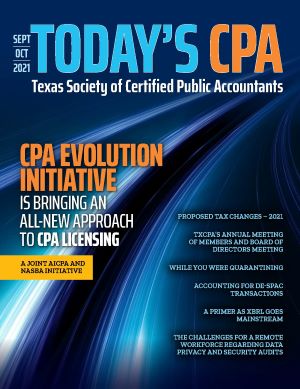Accounting for de-SPAC Transactions
By Josef Rashty
Special Purpose Acquisition Companies (SPACs) offer an appealing alternative to the costly and time-consuming traditional initial public offerings (IPOs) for companies in burgeoning industries. SPACs, also called “blank-check companies,” are shell companies that are listed on a stock exchange with the sole purpose of acquiring a private company to take it public.
The private company (target company), often a startup, then takes the SPAC’s place in the stock market as a public company. Merging with a SPAC has become a popular way for companies to go public because the process has more lenient regulatory requirements and often brings outsized returns for investors.
The Securities and Exchange Commission (SEC) has recently reinforced its focus on the importance of corporate governance and financial reporting by SPACs. Several senior SEC regulators have issued statements warning companies going public through deals with SPACs against issuing enticing but misleading financial disclosures about their companies and their future prospects.
This article explicates some of the accounting issues related to SPAC transaction, and its goal is to elucidate the fundamental concepts of de-SPAC mergers within the framework of Financial Accounting Standards Board (FASB) and SEC guidance. Exhibit 1 defines some of the terminologies that this article has used.
Definition of SPACs
A SPAC is a newly formed company that raises cash through an IPO. Then, it uses that cash or its own initial equity, or often both, to finance the acquisition of a privately held target company. SPACs are nonoperating public companies (i.e., shell companies) and usually do not have any assets on their balance sheets other than cash.
Subsequent to an IPO, the SPAC management commits itself to complete the acquisition of a target company within a certain timeframe (usually two years or less). If SPACs cannot complete an acquisition within the specified timeframe, they liquidate and return the remaining IPO proceeds to SPAC shareholders.
SPACs used to be a little-known corner of capital markets, but they have experienced spectacular growth in recent years. However, they have been under scrutiny recently, and the U.S. securities regulators have opened inquiry into blank check acquisition frenzy and are seeking information on how underwriters are managing the risks involved.
For example, in April 2021, the SEC issued a statement and the staff commented that it is more appropriate for companies to classify the SPACs’ warrants as liability. Some Wall Street analysts have argued that the recent increased regulatory scrutiny has already cooled down the SPACs hot market to some degree.
SEC Filing Requirements
A management team, or a sponsor, with nominal invested capital initially forms a SPAC. The SPAC subsequently files for an IPO, which results in the transfer of approximately 80% of its equity to the public. SPACs file a Form 8-K after their initial IPO and to register the issued securities, they file a Form S-1. SPACs are subject to SEC reporting requirements subsequent to the effectiveness of their Form S-1. Meanwhile, SPACs hold the funds that they have raised in a trust account while they search to acquire a target company.
Once SPACs identify a target company for a potential acquisition, their shareholders vote on the acquisition of the target company. To solicit shareholders’ votes on the merger, SPACs prepare a proxy statement on Schedule 14A (a proxy statement). If SPACs register securities as part of the de-SPAC transaction, they file joint registration and proxy statements on Form S-4 (Form S-4/proxy statement) in lieu of a proxy statement.
The newly formed company has four business days to file a special Form 8-K (Super 8-K) that includes the information that would have been required if the target were filing for an initial registration on Form 10-K. The requirements for financial statements (in compliance with GAAP and SEC promulgations) and SEC review process are largely consistent with a traditional IPO.
Furthermore, SPACs and their target companies may need to secure additional financing to facilitate the acquisition. They can obtain this additional financing through funding and investment by a private investment company (PIPE). PIPEs usually close contemporaneously with the acquisition or shortly after acquisition of the target company. The newly formed company needs to file a Form S-3 for any PIPE financing.
Financial Reporting Requirements
Audited Financial Statements
The SEC requires that the target company provide three years audited financial statements. The target company may provide two years audited financial statements if it meets one of the two following criteria:
- It is a smaller reporting company (SRC) (i.e., it reported less than $100 million in annual revenues or had a public float less than $250 million-Item 10(f)(1) of Regulation S-K).
- It is an emerging growth company (EGC) if it has annual revenues of less than $1.07 billion during the most recently completed fiscal year and has not issued more than $1 billion of nonconvertible debt over the past three years.
Target companies need to adopt GAAP reporting requirements applicable to public companies for their audited financial statements if they have been following Private Company Council (PCC) guidance for reporting prior to their de-SPAC transaction.
Internal Controls Over Financial Reporting (ICFR)
Pursuant to the Sarbanes-Oxley Act of 2002 (SOX), public companies include in their filings an annual management assessment of ICFR under Section 404(a) and an annual attestation report from the issuer’s independent auditors under Section 404(b). Since a SPAC is already a public company, the newly formed company may not be eligible for the transition reporting relief that exempts companies from this requirement subsequent to their IPOs.
The SEC has delayed external auditor’s attestation under Section 404(b) for companies that are qualified as SRC and EGC. In case of a reverse merger, however, when it is not feasible to evaluate ICFR, the SEC permits the combined company to exclude management’s assessment and the auditor’s attestation of ICFR (SOX Section 404(a) and 404(b)) for the fiscal year in which a reverse merger was completed.
Section 302 of SOX requires that the principal executive and financial officers of a company, typically the CEO and CFO, personally attest that financial information is accurate and reliable. They must make these attestations within the quarterly 10-Q and annual 10-K reports that their companies file with the SEC.
Section 302 certification usually covers the implementation and maintenance of a company’s internal controls and procedures, as well as the reporting of deficiencies or changes related to internal controls. However, the SEC has advised companies that are not subject to Section 404 to omit references to ICFR in their Section 302 statements.
Section 906 of SOX requires that public companies include a specific written certification of the CEO and CFO in each periodic report containing financial statements. SOX imposes penalties if information in Forms 10-Q and 10-K do not fairly represent the financial condition and results of operations of the company.
Unaudited Financial Statements
The target company is not required to file any interim financial statements if the de-SPAC filing date (mailing or effective date) does not exceed 134 days from the last audited year-end balance sheet date. However, if the audited financial statements date is 135 or more days from the filing date (mailing or effective date), then the target company must file interim unaudited financial statements.
Determination of the Acquirer
De-SPAC transactions are generally within the scope of ASC 805, Business Combinations. An important accounting judgment in de-SPAC transactions is determination of the accounting acquirer. The accounting acquirer, not necessarily the legal acquirer, is the entity that obtains control of the newly formed reporting entity.
In a de-SPAC transaction, if the SPAC transfers cash and assets to a target company, it can be presumed automatically that it is the acquirer. In most instances in de-SPAC transactions, the acquirer is a SPAC and the acquiree is a target company.
Another complication is the accounting model applicable to a target company; for example, the target company may be considered a variable interest entity (VIE). If so, the primary beneficiary (the SPAC) is the acquirer. However, if the voting interest model is applicable, and the merger consideration is equity or a combination of cash and equity, then it may not be clear whether the SPAC or the target company is the acquirer. ASC 805-10-55-11 through 55-15 has guidance on which entity is potentially the acquirer (e.g., relative voting rights or composition of senior management and governing body are among the criteria to be considered).
If the SPAC is the acquirer in the merger transaction, it recognizes assets and liabilities of the target company at fair value in accordance with ASC 805. Furthermore, the SPAC reflects the acquisition accounting and transaction costs of the acquisition in its proforma financial statements in its proxy or Form S-4/proxy statement.
However, if the target company is the acquirer, the SEC and FASB consider it a reverse merger. Companies consider reverse mergers as reverse capitalizations since the SPAC’s only pre-merger asset is most likely its cash and thus it does not meet the definition of business based on ASU 2017-01, Clarifying the Definition of a Business.
The substance of a reverse capitalization is that the target company issues equity shares for the net monetary assets that it receives from the SPAC.
The target company presents the following information in its financial statements in a reverse merger:
• Assets and liabilities at historical cost;
• No goodwill or intangible assets;
• Retained earnings and other comprehensive income at historical values;
• Equity and additional paid-in capital due to transaction.
Contingencies (Assets and Liabilities Acquired)
Contingencies are existing conditions, situations or sets of circumstances resulting in uncertainty about possible gain or loss that will be resolved in the future. The acquirer (most likely the SPAC) records the contingencies as a result of a de-SPAC transaction based on ASC 450, Contingencies as follows:
• Initial accounting at acquisition date: it records the contingencies at fair value if they are probable and the amount of asset and liability can be reasonably estimated.
• Subsequent accounting (post combination): it adjusts contingencies at the higher of (1) best available estimate or (2) acquisition date fair value less any amortization.
Contingent Considerations
In a de-SPAC transaction, the SPAC acquirer may have uncertainty regarding the fair value of the target company. One way to address this concern is for the SPAC to enter into agreements with the shareholders and employees of the target company to issue additional shares or release shares from escrow or other restrictions during the post-merger period if the target company meets certain performance obligations (e.g., meeting certain sales level or achieving a stock price hurdle).
Furthermore, the SPAC may enter into a transaction for its own benefit or for the benefit of the newly formed company. These transactions should be accounted for separate from the acquisition. The following is a list of such transactions:
• Settle a preexisting relationship (ASC 805-10-55-20 through 55-23);
• Compensate employees for future services – compensation earn-out (ASC 805-10-55-24 through 55-26); and
• Reimburse the former owners for acquisition related costs – shareholders earn-out (ASC 805-10-25-23).
Settlement of Preexisting Relationship
The SPAC and target company may have a preexisting contractual or noncontractual relationship (e.g., the target company has an arrangement to rent a space to the SPAC). If a de-SPAC transaction in effect settles a preexisting relationship, the acquirer (most likely the SPAC) recognizes a gain or loss for the settlement of such preexisting relationship.
Earn-out Provisions in de-SPAC Transactions
ASC 805 provides eight indicators to assess whether a contingent payment is part of a business combination or a post-combination compensation cost. Generally, contingent payments to selling shareholders that remain employed and are providing future services are post-combination compensation costs, particularly if a contingent payment is forfeited upon termination of employment. Today’s CPA published the following two articles that discuss earn-out provisions:
- Compensation Earn-Outs and Post Business Combination Earning Surprises (Josef Rashty, March/April 2012)
- Shareholders’ Earn-Outs and Earnings Management (Josef Rashty, March/April 2014)
ASC 805-10-55-25 has the criteria included in Exhibit 2 to identify if contingent consideration is part of the business combination or post-business combination compensation cost.
Earn-outs may include the issuance of additional securities or distribution of cash or other consideration based on certain post-combination events (e.g., earnings, stock prices or other factors). Earn-out securities in de-SPAC transactions are usually one of the following types:
- Non-qualified stock options (NQSOs);
- Restricted stock units (RSUs);
- Restricted stock (RS);
- Warrants. (These types of warrants are usually accounted for under ASC 718. If not, they are within the scope of ASC 480, ASC 815-10 and 40. (The newly formed company, rather than the SPAC, issues these warrants and their accounting treatment is different than SPAC warrants discussed later in this article.)
An acquirer recognizes earn-out considerations at their acquisition-date fair value as part of the consideration transferred in the acquisition (ASC 805-30-25-5) and classifies it as equity, an asset or a liability.
Contingent consideration classified as equity is not remeasured after the acquisition date and subsequent settlement is accounted for within equity.
Contingent consideration classified as liability (or asset) is remeasured at the end of each reporting period until the contingency is ended. Companies recognize changes in fair value of contingent considerations in earnings unless the contingency is a derivative and has been designated as a hedging instrument in a cash flow hedging relationship. (Topic 815 requires that companies recognize any changes in fair value initially in other comprehensive income.)
Share-Settleable Earn-Out Arrangements (Shareholders Earn-Outs)
Due to uncertainty in the fair value of the target company, a SPAC may agree to enter into shareholders earn-out arrangements with the target’s shareholders, the SPAC’s sponsors or both. SPACs’ shareholders earn-outs have the following characteristics:
- A newly formed company issues additional shares to beneficiaries (cannot be cash settlement awards) if certain events occur or certain conditions are met (e.g., stock prices remain within a certain range or achieving certain revenue targets).
- A newly formed company issues all committed shares, not previously issued, upon the occurrence of certain events (e.g., change of control).
Shares in any shareholders earn-out arrangements are often in the form of restricted stock (RS) and subject to either transfer restrictions or forfeiture upon occurrence of certain events or conditions.
Compensation Earn-Out Arrangements
Compensation earn-outs are contingent post de-SPAC expenses. A SPAC promises certain compensation in the form of stock awards or cash to certain key employees of the target company to maintain their services for a certain period of time or ensure achievement of certain goals within a period of time subsequent to the de-SPAC transaction.
Companies usually condition earn-outs based on service, performance or market conditions (e.g., absolute or relative stock price hurdle). Accounting for stock compensation award arrangements is within the scope of ASC 718, Compensation – Stock Compensation.
SPAC Warrants
Since a SPAC has no means of making money until it identifies and then merges with a target, it issues warrants as an enticement to its sponsors and investors to gain over and above anything their shares may generate. The accounting issue centers on whether such warrants are being categorized properly in the financial statements of the preparer.
The units sold in a SPAC IPO typically comprise one share of common stock and a warrant to purchase one-half of one share of common stock in the future. The SPAC issues warrants, which become exercisable shortly after the de-SPAC transaction, with a strike price that is out of money (usually 115% of the price per unit in the IPO).
SPACs have typically treated these warrants as equity instruments, but the SEC has started to look closely at the accounting practices connected with these accounting practices and has noted potentially problematic patterns. In Apri1 2021, the SEC staff stated that such warrants, depending on their terms, should not be treated as equity investments but it is rather more appropriate that SPACs treat them as liabilities.
Companies need to update the valuation of liability classified awards each reporting period and reflect the changes in fair values in earnings. Therefore, SPACs, which have classified these awards as equity and now need to reclassify them as liability, may need to restate their financial statements for prior periods.
Warrants are common features in SPAC transactions, which SPACs typically grant to their initial investors. Companies classify these warrants as either equity or a liability. The SEC has the following two conditions for SPACs to classify the warrants as a liability:
1. The warrant settlement varies depending upon the characteristics of the holder of the warrant. (GAAP requires liability classification since the holder is not an input into the pricing of a fixed-to-fixed option on equity shares).
2. In the event of a tender or exchange offer made to and accepted by holders of more than 50% of the outstanding shares of a single class of common stock, all holders of the warrants are entitled to receive cash for their warrants. (GAAP requires liability classification for such warrants since it is within the SPAC’s control.)
Earnings Per Share Calculation
The recipients of stock compensation awards may be entitled to the dividends that companies pay on their underlying equity shares while the stock awards are still outstanding but not vested (ASC 718-10-55-45). FASB considers these divided-protected stock awards as participating securities under certain conditions.
Share-based payments that include dividend-protection features, such as dividend payments or adjustments to the exercise price for dividends declared, have certain accounting implications for expense recognition and earnings per share (EPS) calculation. The dividend-protected features of stock awards impact their fair values and most likely determine their status as participating securities. Participating securities have certain accounting and tax implications and may require companies to calculate their EPS pursuant to the two-class method under ASC 260.
SEC Expectation
The SEC views de-SPAC transactions no differently than conventional IPOs and expects the combined public company to have in place both the right people and processes to produce high quality financial reporting that meets SEC rules and regulations (including robust de-SPAC disclosures).
An Alternative to Traditional IPOs
SPAC transactions have become a preferred way for the management team to take companies public in many instances. Initially, SPACs raise capital through an IPO for the purpose of acquiring target companies. Subsequently, target companies, in lieu of executing their own IPOs, decide to merge or be acquired by SPACs and become a publicly held listed company.
De-SPAC transactions may be completed usually in three to four months, which is substantially shorter than a typical traditional IPO timeline. However, most of the accounting and filing requirements in a de-SPAC transaction remain more or less the same despite the compressed timeline of a SPAC merger. Therefore, project management is essential to reduce costs and increase efficiencies to accommodate compliance with accounting and reporting requirements.
Since private target companies can be brought into public markets more quickly through a de-SPAC transaction than the traditional IPO process and because many private companies are in earlier stages of development compared to pre-IPO companies, the target company might not be prepared for certain regulatory demands and new risks of being a public company. These demands and risks include new financial reporting processes and SEC filing requirements (including ICFR reporting and disclosures) under accelerated timelines and deadlines that cannot be missed, new regulatory and listing requirements, and additional communications with shareholders, analysts and the media.
The newly formed companies may need to have in place a more sophisticated and experienced management team to implement compliance with regulatory requirements.
About the Author: Josef Rashty, CPA, Ph.D. (Candidate) is a member of the Texas Society of CPAs and provides consulting services in Silicon Valley, California. He can be reached at jrashty@josefrashty.com.

















